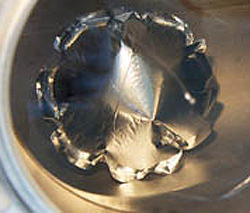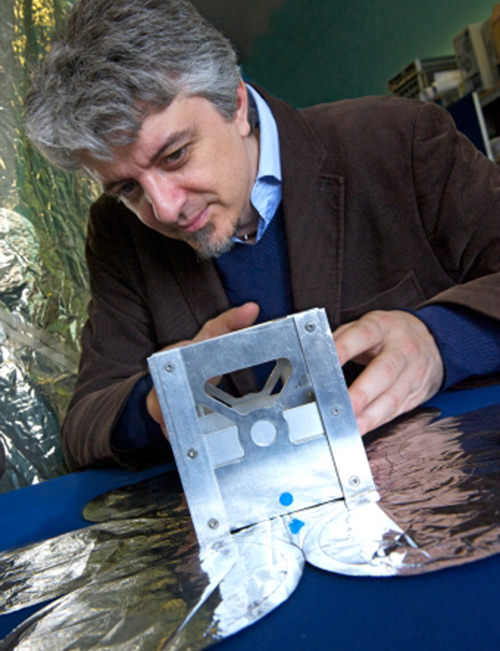[/caption]
The dream of clean, consistent and renewable space solar power may become a reality, thanks to new research being done at The University of Strathclyde in Glasgow, Scotland.
The concept of space solar power — gathering solar energy with satellites in low-Earth orbit and “beaming” it down to collection stations on the ground — has been around for decades, but technology restrictions and prohibitive costs have kept it in the R&D phases, with some doubting that it will ever happen at all.
Now, researcher Dr. Massimiliano Vasile, of the University of Strathclyde’s Department of Mechanical and Aerospace Engineering, has announced his team’s development of modular devices that could be used to gather solar energy in orbit, working atop an experimental “space web” structure developed by graduate students at the university’s Department of Mechanical and Aerospace Engineering.
“By using either microwaves or lasers we would be able to beam the energy back down to earth, directly to specific areas. This would provide a reliable, quality source of energy and would remove the need for storing energy coming from renewable sources on ground as it would provide a constant delivery of solar energy.”
– Dr. Massimiliano Vasile, University of Strathclyde
The web structure, part of an experiment called Suaineadh — which means “twisting” in Scottish Gaelic (and I believe it’s pronounced soo-in-ade but correct me if I’m wrong) — is made of a central hub that would go into orbit and release a square web of material that’s weighted at the corners. The whole apparatus would spin, keeping its shape via centrifugal force and providing a firm structure that other devices could build upon and attach to.
The Suaineadh experiment was successfully launched on March 19 aboard a Swedish sounding rocket and while it appears that the components worked as expected, communication was lost after ejection. As a result the central hub — with all its data — couldn’t be located after landing. A recovery mission is planned for this summer.
Meanwhile, Dr. Vasile is still confident that his team’s space solar project, called SAM, can help provide space solar power to remote locations.

“The current project, called SAM (Self-inflating Adaptable Membrane) will test the deployment of an ultra light cellular structure that can change shape once deployed,” Dr. Vasile explains. “The structure is made of cells that are self-inflating in vacuum and can change their volume independently through nanopumps.
“The independent control of the cells would allow us to morph the structure into a solar concentrator to collect the sunlight and project it on solar arrays. The same structure can be used to build large space systems by assembling thousands of small individual units.”
By collecting solar energy in space, where the constraints of day and night or weather variability are nonexistent, the satellites could ultimately beam clean energy down to otherwise off-the-grid locales.
“In areas like the Sahara desert where quality solar power can be captured, it becomes very difficult to transport this energy to areas where it can be used,” says Dr. Vasile. “However, our research is focusing on how we can remove this obstacle and use space based solar power to target difficult to reach areas.
“By using either microwaves or lasers we would be able to beam the energy back down to earth, directly to specific areas. This would provide a reliable, quality source of energy and would remove the need for storing energy coming from renewable sources on ground as it would provide a constant delivery of solar energy.”
If successful, the Suaineadh/SAM project could develop into a source of renewable energy for not only small, remote locations but also neighborhoods, towns and perhaps even entire cities.
“Initially, smaller satellites will be able to generate enough energy for a small village but we have the aim, and indeed the technology available, to one day put a large enough structure in space that could gather energy that would be capable of powering a large city,” Dr. Vasile says.
Read more on the University of Strathclyde Glasgow’s site here.
Image credits: The University of Strathclyde. The project is part of a NASA Institute for Advanced Concepts (NIAC) study.


Is it just my browser (Chrome) or has somebody been messing about with the font style here?
at this point chrome has issues, they will fix it up,
It’s changed from something like Times Roman to something else like Arial. For both of these font choices, upper case I looks a lot like lower case L, but it is easier to read the numeral 1 in Arial.
Some browsers (e.g. Firefox) let you enforce your own font choice, size and background color overriding the website’s style sheet choices. You should be able to change the font to StarTrek, LED, Ransom Note, etc. or back to Times Roman as desired in your browser preferences.
It’s not just you – looks like the font has been changed to Lustria
I find it odd they picked ” ‘Lustria’, arial, serif; ” for the font-family. Arial will only work in quotes, and is a sans-serif font, while the other two options are serif.
I like it!
I was at the International Space Development Conference in Washington DC last weekend and without a doubt, the topic of space solar power was greatly talked about. With such a promising energy solution for our world, one speaker even stated that this may one day end wars (energy related conflicts). While that sounds like a very far-fetched claim, I feel that there may be some partial truth to it. With clean energy for all, maybe most fighting over energy will stop..sure doesn’t hurt to dream about it.
Anyone care to disqus?
Not to down play the technical feasibility of idea, but wouldn’t roof-top solar and/or solar parks have to catch on in a big way before power utilities looked at space based solar collectors? The Middle-East, Australia, Central America and equatorial countries have high annual sunshine hours, yet even with the incentive of carbon emission caps and trading schemes, solar doesn’t rate (currently only 67,400 MW or 0.5 % of global electricity demand). Add the expense of installing and maintaining such systems in space and the utility companies will show even less interest.
Energy balance: Consider a space based solar collector’s life time and ROI. Currently, it takes 1 to 4 years to recoup the energy needed to manufacture standard photo-voltaic (PV) cells. More energy would be required to make rad hardened PV cells that survive the harshness of space plus there’s the energy cost of raising them to orbit. How many more years does this add before you recoup your cost and what proportion the orbiting solar collectors operating lifetime is that?
Selecting an orbit: If you select an LEO orbit, night time cuts your generation cycle to a maximum of 12 hours per day. If you select a polar or sun centric orbit, you can get full sun exposure, but your utilities’ ground based collection station doesn’t always have a line-of-sight to the orbiting solar collector.
The big energy consumers, China and the US (even with a clean energy enlightened President) doesn’t seem likely to switch from burning coal or natural gas for 2/3’s of electricity production for solar any time soon.
We are not talking about lofting a domestic solar panel into space. Your domestic solar panels are big, heavy things. In space, your solar panel light be a micron or so thick. You do not have to make the surface cleanable, because pidgeons will not crap on it. You do not have to harden the design against radiation or micrometeorites if you can just write off a small region.
Something that size would act as a substantial solar sail. This would allow it to raise itself from LEO. Or to sail in from the moon if we started making the bits on the moon.
I would be more worried about the power transmission device: this would have to work at high efficiencies for many years without maintenence. Yes, it’s all sounds a bit science-fiction-ish. But you might make the money sums balance one day.
Ah thanks Richard Kirk. So in the fine tradition of journalistic clichés, we should “watch this space”.
Cheers
Whenever I see an article on orbital solar power, I immediately think of the military applications of the energy downlink – imagine a satellite with the ability to fire a focused laser or microwave beam to any location on the planet. It would be the ultimate death ray – perfect for assassinations
I imagine most people would fear such a development but in all honesty I think it would be welcome – the ability to assassinate military and political leaders directly would remove the need to engage in bloody confrontations between armies and even missiles (nuclear or otherwise) might be rendered obsolete. Ships could be disabled by incinerating their bridge staff, instead of sinking them and risking far more lives. A nation could be subjugated by incinerating their political leaders, instead of bombing their cities and taking so many civilian lives.
How it would play out politically is anyone’s guess, but I’d wager that far more people would survive war if nations had this technology, and war would occur far less in any case.
most wars are religious in nature.
mirrors can be made of very light weight materials and concentrate a lot of energy in the vacuum of space. the next problem becomes how to convert, store and transmit the harvested sunlight. these methods could be very useful for exploring the outer solar system.
as for the earthly uses, the petroleum industry will oppose any alternatives until all the sludge is extracted. i can see it now- “solar psychos propose to build pie-in-the-sky death ray to fry us all!”
haha yea I can see that happening, they will somehow eat at every flaw and turn it into a nightmare scheme so that they can squeeze out every last oil dollar possible.
But maybe by the time SBSP becomes technologically and economically feasible a couple of decades down the line, oil will have become scarcer and possibly dirtier.
http://phys.org/news/2012-05-sharp-solar-cell-worlds-highest.html
Interesting side effect … because this method would effectively increase the amount of solar radiation received by the earth, and because one way or another the energy will end up as heat when it’s used on the ground, this clean energy source would actually be a contributor to global warming.
Yes, insignificant compared to the heat released from burning coal to make the same power (let alone the effect of the greenhouse gases released from burning that coal), but still a contribution.
The dream of clean, consistent and renewable space solar power may become a reality. The concept of space solar power – gathering solar energy with satellites in low-Earth orbit and “beaming” it down to collection stations on the ground. By collecting solar energy in space, where the constraints of day and night or weather variability are nonexistent, the satellites could ultimately beam clean energy down to otherwise off-the-grid locales. In areas like the Sahara desert where quality solar power can be captured, it becomes very difficult to transport this energy to areas where it can be used.
http://www.globalsolarbrokers.com/